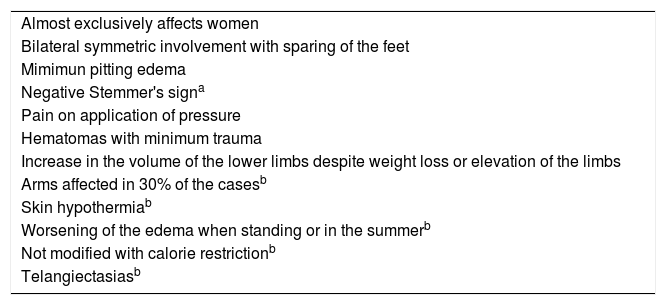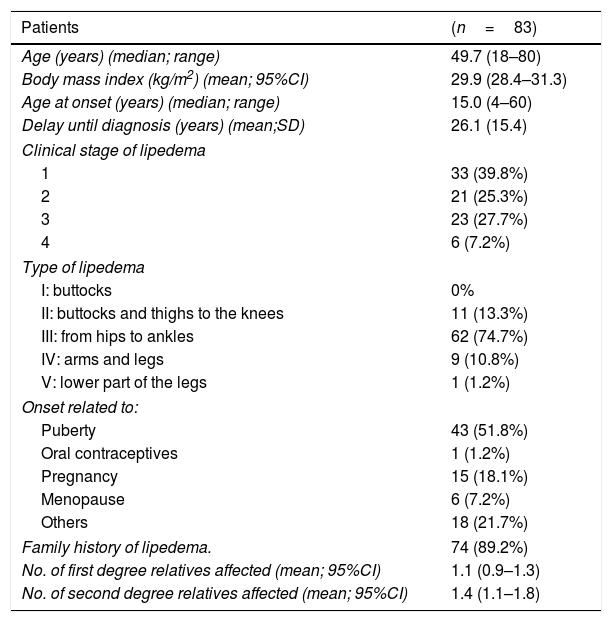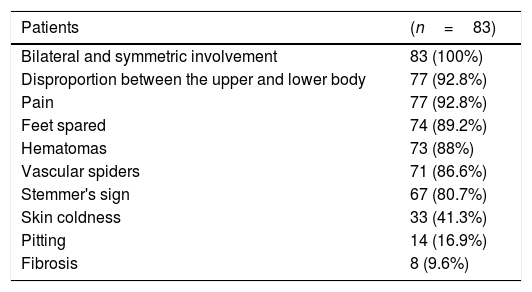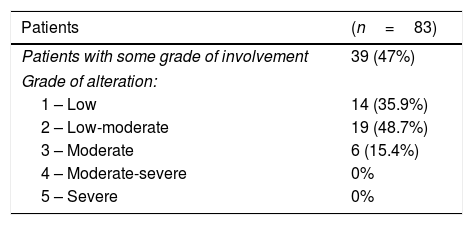Lipoedema is a syndrome that is characterized by edema, an accumulation of fat, pain and haematomas in the lower limbs that principally affects women. Diagnosis is currently based on clinical criteria, since there is no accurate diagnostic imaging for the condition. The aim of our study was to describe the lymphoscintigraphic findings in patients with lipoedema.
Material and methodA prospective cohort study of women with clinical criteria of lipoedema who underwent lymphoscintigraphy. Two independent nuclear physicians described and classified the lymphoscintigraphy findings in different grades of severity, according to the migration and distribution of the radiopharmaceutical.
Eighty-three patients were included with a median age of 49.7 years (range: 18–80) and a mean body mass index (BMI) of 29.9kg/m2 (95% CI: 28.4–31.3).
ResultsLymphoscintigraphy showed alterations in 47% of the patients, most were low (35.9%) or low-moderate grade (48.7%). None of the patients were severely affected (no migration of the radiopharmaceutical).
The degree of lymphoscintigraphic involvement showed no relation to age (p=0.674), Stemmer's sign (p=0.506), or BMI (p=0.832). We found lymphoscintigraphy findings in all the clinical stages of lipoedema, with no significant differences between the grade of lymphoscintigraphic involvement and the clinical stage of lipoedema (p=0.142).
ConclusionAlthough lymphoscintigraphy has been used to differentiate lipoedema from lymphoedema, we found frequent alterations in the patients with lipoedema, therefore the presence of findings does not rule out a diagnosis of lipoedema.
El lipedema es un síndrome caracterizado por edema, acúmulo de grasa, dolor y hematomas en miembros inferiores que afecta principalmente a mujeres. Su diagnóstico actual se basa en criterios clínicos, dado que no tiene un diagnóstico de imagen de certeza. El objetivo de nuestro estudio fue describir los hallazgos linfogammagráficos observados en pacientes con lipedema.
Material y métodoEstudio de cohortes prospectivo de mujeres con criterios clínicos de lipedema a las que se realizó una linfogammagrafía. Dos médicos nucleares independientes describieron y clasificaron los hallazgos linfogammagráficos en diferentes grados de gravedad, en función de la migración y de la distribución del radiofármaco.
Fueron incluidas 83 pacientes con una mediana de edad de 49,7años (rango: 18-80) y un índice medio de masa corporal (IMC) de 29,9kg/m2 (IC 95%: 28,4-31,3).
ResultadosEn el 47% de las pacientes se observó alguna alteración en la linfogammagrafía, siendo en la mayoría de bajo grado (35,9%) o de grado bajo-moderado (48,7%). Ninguna presentó afectación severa (no migración del radiofármaco).
El grado de afectación linfogammagráfica no presentó relación con la edad (p=0,674), ni con el signo de Stemmer (p=0,506), ni con el IMC (p=0,832). Encontramos hallazgos linfogammagráficos en todos los estadios clínicos de lipedema, sin diferencias significativas entre el grado de afectación linfogammagráfico y el estadio clínico del lipedema (p=0,142).
ConclusiónAunque la linfogammagrafía se ha empleado para diferenciar lipedema de linfedema, encontramos alteraciones frecuentes en las pacientes con lipedema, por lo que la presencia de hallazgos no descarta el diagnóstico de lipedema.
Article
If you experience access problems, you can contact the SEMNIM Technical Secretariat by email at secretaria.tecnica@semnim.es or by phone at +34 619 594 780.

Revista Española de Medicina Nuclear e Imagen Molecular (English Edition)














